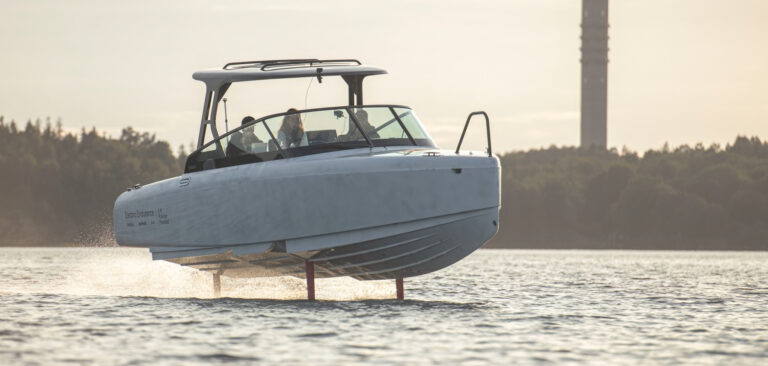Swedish electric boat manufacturer Candela’s latest version of its C-8 foiling craft covered 420 nautical miles – equivalent to 777km/483 miles – within 24 hours in the Stockholm archipelago. The prior claimed record was 79 nautical miles achieved in 20 hours.
The circuit consisted of a 20-nautical-mile loop between Frihamnen and the island of Tynningö. During the 24 hours, the C-8 charged for a total of 313 minutes and received a total of 615kWh of electrical energy. Each charge took about 18 minutes, and the battery was charged from about 13% to 66% state of charge (SOC). The Candela C-8 had an average charging speed of about 118kW and the vessel maintained an average speed of slightly over 17kts during the race, including charging breaks.
While conventional planing electric boats face challenges due to water friction, leading to shorter ranges, the C-8 uses hydrofoil technology – wings slung under the hull – to reduce energy usage by 80%. This results in a range that’s two to three times longer than that of traditional electric boats. Moreover, the C-8 can be DC-charged thanks to Candela’s partnership with electric car company Polestar, which supplies both batteries and charging for the C-8. Together, this makes extended journeys using battery power feasible for the first time.
Candela conducted the record run in collaboration with battery maker Northvolt and charging station supplier Plug, to showcase how future DC charging networks for boats could look like in archipelagos and remote coastal areas. Instead of making heavy investments in upgrading the local grid, islands can deploy battery systems like Voltpack to ensure that there’s enough power available for fast charging.
The record run was enabled by Northvolt’s mobile battery storage system Voltpack, which was used to DC charge the C-8 during the record run. On the dock was a 281kWh Voltpack system and a Plug DC charger, which enabled rapid charging of the C-8’s battery. The route was a loop between Stockholm and the island of Tynningö, with DC charging after each lap.
The C-8, running at full speed, 27kts most of the time, consumed 685kWh during its journey, costing about €110-€120 (US$117-US$127) in electricity. In contrast, a conventional petrol-powered boat would consume roughly 750 liters of gasoline, costing approximately €1,400 (US$1,490).
“This feat shows that fast, electric waterborne transport over long distances is viable today, not a distant future” said Gustav Hasselskog, Candela’s CEO and founder, who piloted the C-8 during the record attempt. “With a relatively modest investment, charging stations could be built to fully electrify marine transport in the Stockholm archipelago. For a few hundred million euros, a charging network covering Europe’s coastal passenger transports would become a reality. We don’t have to wait for tomorrow. We have the technology to shift toward sustainable marine transport now.”
Candela intends to introduce its new passenger vessel, the 30-person Candela P-12 Shuttle, this autumn. This vessel can operate on most of the world’s coastal waterways while offering a sustainable and much more cost-effective alternative to today’s fossil-fueled waterborne traffic, which accounts for 3% of global GHG emissions.



